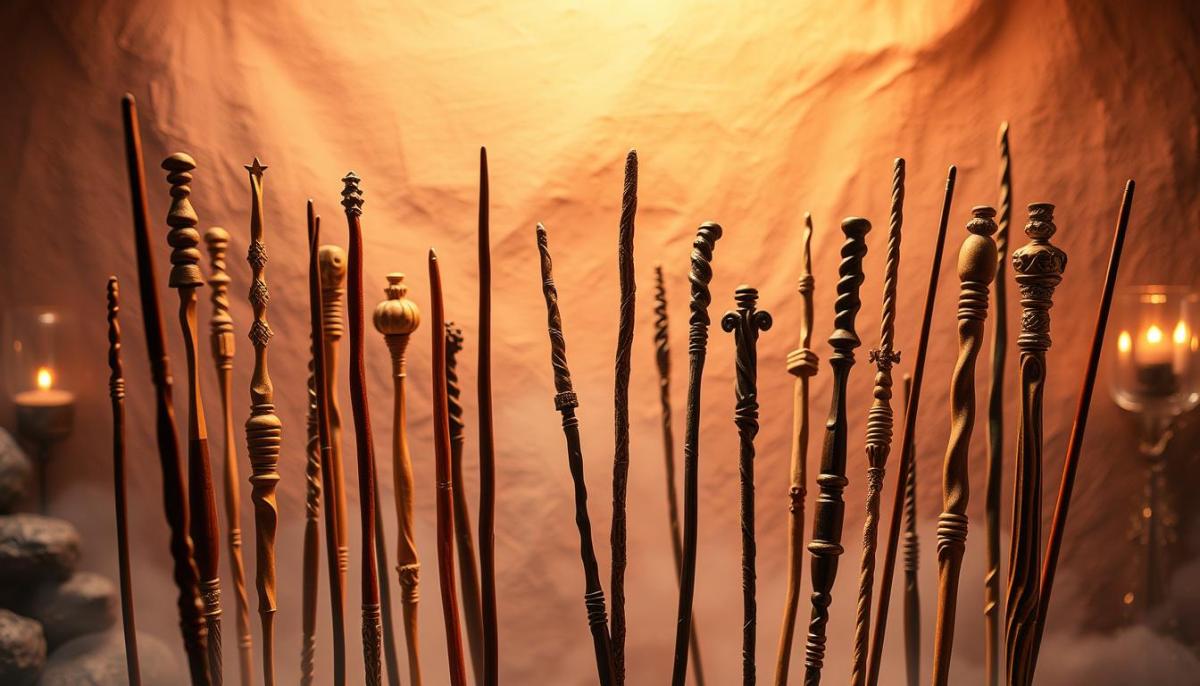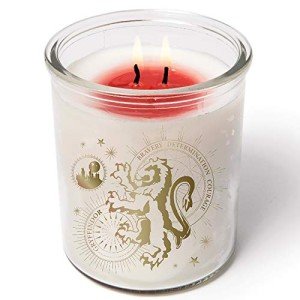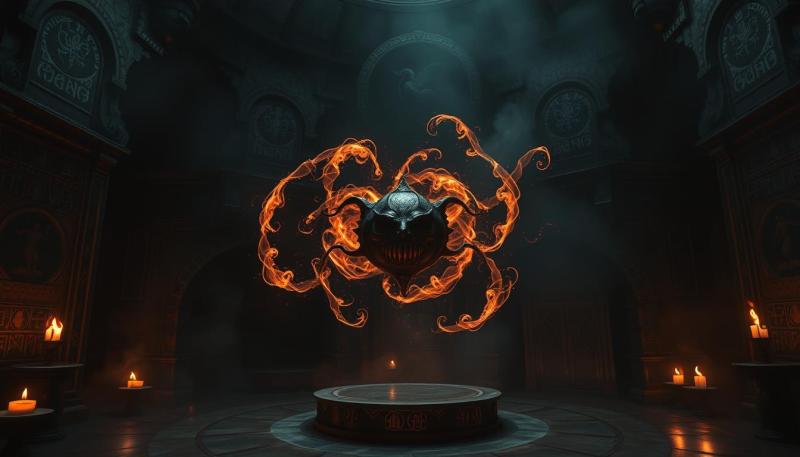Do you remember the magical moment when you first saw a young wizard enter Ollivander's shop? The shelves were filled with mysterious boxes, each holding a unique wand. This moment of wonder stays with us long after we finish reading or leave the theater.
The magical sticks used by witches and wizards in J.K. Rowling's world are more than simple tools. They are extensions of the user's essence. They channel inner power into magic that can change, protect, or harm.
What makes these magical sticks so captivating isn't just their spell-casting ability. It's the complex system of wandlore created by Rowling. Wood types, magical cores, and lengths all shape a wand's personality and its match with its owner.
In this guide, you'll learn about the basic parts of these magical tools and the famous wands of beloved characters. You'll understand why "the wand chooses the wizard" is so meaningful in this world.
Whether you're a casual fan or a dedicated Potterhead, join us. We'll explore the fascinating magical properties of these extraordinary instruments. They have captured the hearts of millions around the world.
Key Takeaways
- Wands serve as extensions of a witch or wizard's magical abilities, not just as tools
- J.K. Rowling created an intricatwandlore system with specific woods and magical cores
- The relationship between wand and wizard is unique, with the wand choosing its owner
- Different components (wood, core, length) contribute to a wand's personality and power
- Famous character wands reflect their owners' personalities and magical abilities
- Understanding wandlore adds significant depth to the magical world's lore
The Magic Behind Wands in Harry Potter
Wands are key in the Harry Potter world. They are simple wooden tools with deep magic and a special bond with their users. These objects mix nature and magic perfectly. Most magic users need wands to control their spells.
Wands and their users share a deep bond. This bond grows as the user learns magic. It's more than just owning a wand; it's a magical partnership.
The Essential Role of Wands in Wizarding Society
Getting your first wand is a big moment in magic learning. Without a wand, magic is hard to control. Wands help users cast spells accurately and safely.
Wands are very important in magic culture. If a wizard is kicked out of school, their wand is snapped. This shows how vital wands are to magic society.
Different magic groups have their own wand traditions. But everyone respects these powerful tools. Wands help with magic in many ways, from dueling to everyday spells.
The Wand Chooses the Wizard: Understanding the Selection Process
The wand selection is mysterious and magical. Garrick Ollivander says, "The wand chooses the wizard." When you find your wand, you'll feel a special connection, like warmth or sparks.
Wands seem to know their wizard. They sense the wizard's magic, personality, and future. This bond grows stronger over time.
- Magical ability and skill
- Personality and traits
- Future and destiny
This bond makes the wand adapt to the wizard. Wandmakers believe only the true owner can unlock the wand's full power.
Ollivander's: The Ancient Art of Wandmaking
Ollivander's wand shop is famous in Britain. It's been around for over 1,800 years. The Ollivander family is known for their wandmaking skills.
Garrick Ollivander knows a lot about wands. He believes each wand is unique, just like its wizard. His careful craftsmanship makes Ollivander's wands special.
At Ollivander's, making a wand is both art and science. Choosing the right wood and core is a precise process. This mix of skill and magic makes Ollivander's wands stand out.
Wand Components and Their Magical Properties
Magical wands have unique parts that make them special. Each wand has a magical core, wood type, and physical features. These elements work together to make wands more than just tools for magic.

Magical Cores: Dragon Heartstring, Phoenix Feather, and Unicorn Hair
Every wand has a magical core at its heart. This core is what makes a wizard's magic work. Garrick Ollivander, a famous wandmaker, uses three main wand cores.
Dragon heartstring cores make wands very powerful. They learn fast but can be hard to control. They bond strongly with their owners.
Phoenix feather cores are rare and mysterious. They can do a wide range of magic and sometimes act on their own. They're picky about who they choose, but the bond they form is deep.
Unicorn hair cores make wands reliable and consistent. They rarely go wrong and stay loyal to their first owner. They're not as strong as other cores but are very dependable.
Wand Woods and Their Unique Characteristics
The wood of a wand affects its personality and how it works. J.K. Rowling based her wand woods on the Celtic tree calendar. Each wood has its own dates and traits.
Holly wands, like Harry's, protect and fight dark magic well. They're often chosen by wizards on dangerous quests. Yew wands are connected to life and death magic, making them powerful but risky.
Other notable woods include Silver Lime for divination, Redwood for those who can adapt, Pine for creativity, and Spruce for spectacular magic. The wood's natural traits mix with the core's magic to create unique wands.
This mix of wood and core makes wands seek out specific wizards. It's why some wands work better with certain wizards than others.
The Significance of Length, Flexibility, and Shape
A wand's length, flexibility, and shape tell us about it and its wizard. These features are not just for looks. They show deeper magical connections.
Wand length often matches the wizard's size and personality. Longer wands go to wizards with big personalities. Shorter wands prefer wizards with precise magic.
Flexibility shows adaptability in both wand and wizard. Flexible wands choose wizards who like change. Rigid wands go to wizards with strong principles.
The shape and design of a wand reflect the wandmaker's skill and serve practical needs. Different shapes channel magic better and help with spellcasting. These small details can greatly affect a wizard's magic, even in complex spells.
Famous Wands in Harry Potter and Their Owners
The wands in Harry Potter are more than just tools. They have their own stories and destinies. These magical sticks have shaped history, connected characters, and sometimes held secrets their owners didn't know. Let's look at some of the most famous harry potter wand types and why they're so special.
The Elder Wand: History, Powers, and Its Bloody Trail
The Elder Wand is the most powerful and dangerous wand in the wizarding world. Made by Death, it's 15 inches long, made of elder wood, and has a thestral hair core. It has a bloody history of betrayal and death.
This wand is special because it changes allegiance when its owner is defeated. Not just by death, as Draco Malfoy showed by defeating Dumbledore. This makes it the most sought-after wand.
The Elder Wand can do magic that no other wand can. It helped Albus Dumbledore and Harry Potter do amazing things. For example, it fixed Harry's broken wand, which was thought impossible.
Many have tried to get the Elder Wand for its power, but they've met a violent end. It's known as "The Deathstick" and "The Wand of Destiny." But Dumbledore and Harry used it wisely, without its destructive power.
Harry Potter Wand - Noble Collection, 14in
Unleash your inner wizard with this beautifully detailed wand that brings magic to life
Product information
SGD 13.58
Product Review Score
4.23 out of 5 stars
206 reviewsProduct links
Harry Potter's Holly and Phoenix Feather Wand
Harry's wand is 11 inches long, made of holly, and has a phoenix feather core. This is a rare combination. The phoenix feather also went into Voldemort's wand, creating a special effect when they faced each other.
Holly wood means protection, and the phoenix feather means rebirth. Harry's wand shows his destiny as a protector who can overcome challenges.
Ollivander said Harry's wand is "nice and supple," showing Harry's growth and adaptability. It was very loyal to Harry, even acting on its own to protect him from Voldemort.
Voldemort's Yew Wand and the Priori Incantatem Effect
Voldemort's wand is 13½ inches long, made of yew, and has a phoenix feather core. Yew trees symbolize death and immortality, like Voldemort's quest to conquer death. The phoenix feather represents rebirth, hinting at Voldemort's many comebacks.
When Voldemort and Harry fought, their wands showed a rare effect. They connected in the Priori Incantatem effect, revealing echoes of Voldemort's past victims. This saved Harry's life and showed a deep magical bond between them.
After this, Voldemort wanted the Elder Wand to overcome this connection. But this decision led to his downfall when he misunderstood the wand's allegiance.
Distinctive Wands of Hogwarts Professors and Order Members
The wands of Hogwarts professors and Order members show their unique personalities and magical skills. Minerva McGonagall's wand is 9½ inches long, made of fir, and has a dragon heartstring core. It reflects her straightforward and determined nature.
Severus Snape's wand matches his strict personality. Albus Dumbledore's original wand, before getting the Elder Wand, was made of elder with a powerful core. It shows his innovative magic and talent.
Hermione Granger's wand is made of vine wood with a dragon heartstring core. It represents her intelligence and vision. Ron Weasley's wands, from unicorn hair to willow, show his growth from being overshadowed to finding his strength.
| Character | Wand Wood | Core | Length | Special Properties |
|---|---|---|---|---|
| Harry Potter | Holly | Phoenix Feather | 11 inches | Twin core to Voldemort's wand |
| Voldemort | Yew | Phoenix Feather | 13½ inches | Twin core to Harry's wand |
| Dumbledore | Elder | Thestral Hair | 15 inches | Most powerful wand ever created |
| Hermione | Vine | Dragon Heartstring | 10¾ inches | Excellent for complex spellwork |
| Ron Weasley | Willow | Unicorn Hair | 14 inches | Loyal and consistent performance |
Wand Magic: Techniques and Advanced Usage
Mastering wand magic is key to being a skilled witch or wizard. Having the right wand is important, but technique and understanding are just as vital. The most powerful spells need precise execution and magical intent.

Proper Wand Movements and Incantations
Spellcasting success relies on precise wand movements. Even small changes in technique can greatly affect a spell's outcome. A simple charm can turn into a disaster or fail completely.
When practicing wand techniques, keep these fundamental principles in mind:
- Use your wrist for most movements
- Keep motions short and precise
- Face the target of your spell directly
- Pronounce incantations clearly and with confidence
Different spells need specific movements. For example, Wingardium Leviosa uses a simple "swish and flick." Healing charms require a complex figure-eight pattern. The right movement and incantation create the magic needed for spells to work.
Professor Flitwick said a spell's power comes from verbal and physical harmony. When these elements match your magical intent, even complex spells become possible for intermediate practitioners.
Wand Dueling: Offensive and Defensive Techniques
Wand dueling is a challenging test of magical skill. A good dueling stance allows for quick casting and defense. It prepares you to cast and counter spells fast.
Defensive techniques focus on protection and disarmament. The Expelliarmus charm, for example, takes an opponent's wand away. Advanced defensive magic includes Shield Charms and the Patronus, which repel threats.
Offensive dueling demands precision, speed, and strategy. Skilled duelists like Dumbledore and Voldemort can chain spells together. This overwhelms their opponents' defenses.
| Dueling Technique | Primary Purpose | Example Spells | Difficulty Level |
|---|---|---|---|
| Disarmament | Remove opponent's wand | Expelliarmus | Beginner |
| Shielding | Block incoming spells | Protego | Intermediate |
| Stunning | Temporarily incapacitate | Stupefy | Intermediate |
| Counter-Cursing | Reverse harmful magic | Finite Incantatem | Advanced |
| Spell Chaining | Overwhelm defenses | Multiple spells in sequence | Expert |
Wand Allegiance and Ownership Transfers
Wand allegiance is a complex topic in wand magic. Wands bond with their owners, but this bond can change. This happens when a wand is won in combat or through disarmament.
The concept of wand allegiance was key in the final battle between Harry Potter and Voldemort. When Harry disarmed Draco Malfoy, he unknowingly gained the Elder Wand's allegiance. This loyalty was key to Harry's victory over Voldemort, whose spells were ineffective against the true master.
Not all wands change allegiance the same way. Some, like those with unicorn hair cores, stay loyal to their original owner. Others, like those with dragon heartstring, may change allegiance more easily when won in a duel.
Understanding wand behavior can give you an edge in magical combat. Knowing when a wand might resist or when an opponent's wand might be on your side can open up new strategies.
Ron Weasley 12-Inch Magic Wand with Spell Card
Experience the magic of Hogwarts with Ron Weasley's authentic wand and spell card that brings your favorite wizarding moments to life
Product information
SGD 25.32 SGD 23.07
Product Review Score
4.5 out of 5 stars
95 reviewsProduct links
Conclusion: The Symbolic Importance of Wands in the Wizarding World
In the Harry Potter series, wands in Harry Potter are mentioned over 1,985 times. This shows how important they are to the story. Wands are more than just tools; they are a part of who their owners are and what they can do.
The idea that "the wand chooses the wizard" is very deep. It means wands have a special kind of awareness. They want to exist and grow stronger. Your wand is like a friend on your magical path.
The materials of wands tell us about their owners. Woods like elder and yew, and cores made from phoenix feathers or unicorn hair, show who they are. Harry's wand, for example, shows his brave and fiery side. The Elder Wand's dark past warns of the dangers of seeking power without wisdom.
Wands are key moments in a young wizard's life. Getting your first wand is like joining a magical family. It connects you to a long history of magic. As you learn more, your bond with your wand grows stronger, just like your own unique identity.
Rowling didn't just create magical tools. She made symbols of who we are, our power, and the special connections we have with magic.









